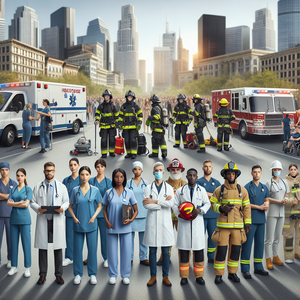Drones in Disaster Response: A New Era of Emergency Management

One of the most significant contributions of drones in disaster response is their ability to conduct rapid aerial surveys. Traditional damage assessment methods often involve sending teams into potentially hazardous areas, which can be both time-consuming and risky. Drones, equipped with high-resolution cameras and various sensors, can quickly gather detailed aerial imagery of affected regions, providing first responders with immediate insights into the extent of the damage. For instance, during Hurricane Harvey in 2017, drones were deployed across Texas to survey flooded areas. The aerial footage captured allowed emergency services to identify the hardest-hit regions, enabling them to prioritize rescue operations effectively. By offering a bird's-eye view of disaster-impacted areas, drones facilitate swift decision-making, ultimately saving lives.
Supporting Example: Hurricane Harvey
The deployment of drones during Hurricane Harvey exemplified their ability to provide real-time data to first responders. By capturing high-resolution images of flooded neighborhoods, agencies were able to assess the severity of flooding and identify residents in need of immediate assistance. This capability not only expedited rescue operations but also allowed for better allocation of resources during an overwhelming crisis.
Damage Assessment and Data Analysis
Beyond the mere capture of aerial imagery, drones come equipped with advanced technologies such as infrared cameras and LiDAR sensors, which can assess structural integrity and identify hazardous conditions. Following the devastating Camp Fire in California in 2018, drones equipped with thermal imaging were employed to analyze the temperature of structures. This allowed teams to determine which buildings were still standing and which were at risk of collapse. The data collected by drones can also be processed using sophisticated software to create 3D models of disaster-stricken areas. These models provide invaluable insights into the aftermath of disasters, assisting urban planners and government agencies in recovery efforts and future preparedness. By leveraging drone technology, responders can build a comprehensive understanding of the damage, allowing for more efficient resource allocation.
Supporting Example: Camp Fire Damage Assessment
After the Camp Fire, drone-based thermal imaging enabled responders to identify hot spots and assess structural risks quickly. This data proved crucial in prioritizing response efforts, ensuring that the most dangerous situations were addressed first—a testament to the predictive power of drone technology in disaster scenarios.
Delivering Supplies and Aid
Drones are not just valuable for assessment; they also play a pivotal role in delivering essential supplies to areas that are difficult to access. In disaster scenarios where roads are blocked or unsafe, drones can transport medical supplies, food, and water directly to those in need. A notable example is the use of drones by the humanitarian organization Zipline, which has successfully delivered blood and medical supplies to remote areas in Rwanda and Ghana. During the COVID-19 pandemic, drones were also utilized to deliver personal protective equipment (PPE) and medical supplies to healthcare facilities in hard-to-reach areas. This capability underscores the potential of drones to bridge logistical gaps, ensuring that aid reaches those who need it most, even when traditional methods fail.
Supporting Example: Zipline's Humanitarian Efforts
Zipline's operations in Rwanda and Ghana have revolutionized the delivery of medical supplies. By using drones to transport blood and vaccines, they have significantly reduced delivery times, overcoming the challenges posed by poor road infrastructure. This model not only illustrates the operational efficiency of drones but also highlights their potential in saving lives during emergencies.
Collaboration with First Responders
The integration of drone technology into disaster response is not a solitary endeavor; it involves collaboration among various stakeholders, including government agencies, private companies, and non-profit organizations. In many instances, local volunteer organizations have stepped up to operate drones during emergencies, providing crucial support to official response teams. A prominent example occurred during the 2020 Australian bushfires, where volunteer drone pilots collaborated with firefighters to provide real-time data on fire behavior and spread. This cooperative effort demonstrated how drones can enhance situational awareness and improve coordination among multiple response teams, ultimately leading to more effective disaster management.
Supporting Example: Australian Bushfires
The involvement of volunteer drone pilots during the Australian bushfires highlighted the importance of community engagement in disaster response. By providing real-time data on fire conditions, these volunteers played a vital role in informing firefighting strategies and ensuring that resources were allocated where they were needed most.
Drones represent a significant advancement in disaster response, offering innovative solutions that enhance efficiency, safety, and effectiveness. From conducting aerial surveys and assessing damage to delivering vital supplies and facilitating collaboration among responders, the impact of drones is profound. As technology continues to evolve, the role of drones in emergency management will likely expand, paving the way for a future where disasters can be managed more effectively, ultimately saving lives and rebuilding communities more swiftly. The integration of drones into disaster response not only exemplifies technological innovation but also underscores the importance of adaptability and preparedness in an unpredictable world. As we embrace these emerging opportunities in drone operations and aerial data analysis, we move closer to a new era of emergency management, characterized by rapid response and resilient recovery.
Drone Operations Specialist
Government agencies, disaster response organizations, private drone service companies
Core Responsibilities
Operate and maintain various types of drones for aerial surveys and data collection during emergency situations.
Conduct pre-flight checks and ensure compliance with all aviation regulations and company policies.
Collaborate with first responders to integrate drone data into real-time disaster response operations.
Required Skills
Proficiency in drone piloting, including knowledge of UAV systems and flight planning.
Familiarity with software for drone data analysis, such as GIS tools.
Strong communication skills for effective collaboration with emergency management teams.
Disaster Response Data Analyst
Non-profit organizations, urban planning agencies, governmental disaster management departments
Core Responsibilities
Analyze aerial imagery and data collected from drones to assess disaster impacts and guide response efforts.
Create detailed reports and visualizations to communicate findings to stakeholders.
Utilize advanced software tools to process and model data, including 3D reconstruction.
Required Skills
Experience with data analysis software (e.g., ArcGIS, QGIS) and proficiency in data visualization tools.
Understanding of disaster management principles and emergency response protocols.
Strong analytical skills with attention to detail for accurate damage assessment.
Aerial Survey Technician
Engineering firms, governmental agencies, environmental consulting companies
Core Responsibilities
Conduct aerial surveys using drones equipped with high-resolution cameras and sensors to monitor disaster areas.
Collect and process data to create detailed maps and reports for emergency responders.
Collaborate with engineers and planners to assess damage and recommend recovery actions.
Required Skills
Technical knowledge of drone technology and survey equipment.
Experience with photogrammetry and LiDAR processing techniques.
Ability to work in high-pressure environments and adapt to rapidly changing situations.
Logistics Coordinator for Drone Deliveries
Humanitarian organizations, logistics companies, health service providers
Core Responsibilities
Plan and coordinate drone delivery operations for medical supplies and humanitarian aid in disaster-stricken areas.
Develop logistics strategies that optimize flight paths and ensure timely deliveries.
Monitor inventory levels and coordinate with suppliers to maintain essential supplies for drone missions.
Required Skills
Strong organizational and project management skills to oversee complex logistics operations.
Familiarity with regulatory requirements surrounding drone deliveries, including airspace restrictions.
Effective problem-solving abilities to address challenges in delivery operations.
Remote Pilot in Command (RPIC)
Emergency response agencies, private drone service providers, research institutions
Core Responsibilities
Serve as the primary pilot for drone missions in disaster response scenarios, ensuring safe and effective operation.
Receive and interpret mission briefs from emergency management teams, adapting flight plans as necessary.
Provide real-time feedback and data updates to ground teams during aerial missions.
Required Skills
FAA certification for remote pilots and experience flying drones in various conditions.
Ability to operate advanced drone systems and navigate using GPS and mapping software.
Strong situational awareness and decision-making skills in emergency environments.


